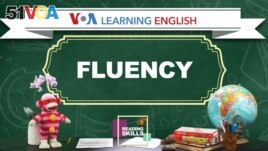15 August 2023
Fluency is the ability to read a text quickly and understand it. It is the bridge between reading a word and comprehension.
What fluency looks like
Fluent readers can do the following:

Early Literacy: Fluency
- They can read with correct pauses and tone of voice or expression.
- They do not spend time figuring out each word.
- They make connections between the text and their own knowledge.
- They understand the larger meaning of the text.
Fluency grows over time, and fluency develops from a lot of practice. To read fluently, readers must be able to divide the text into meaningful "chunks." These chunks, or pieces, include phrases and clauses within a sentence.
Fluency is not a reading stage of development in which students can read all words quickly and easily all the time. Fluency changes depending on the text. A student may be able to read a text they know fluently, but then read a new text very slowly.
Teaching tips for fluency
Read a text out loud. Then, read it again.
Students need to read and then re-read texts out loud to teachers and classmates. Teachers should give feedback. Use activities that make students re-read texts. A good activity for increasing fluency is "reader's theater." A description of this activity comes at the end of the article.
Choose the right text. The texts for fluency practice should not be too easy or too hard. If the text is too hard, students may have to work too hard to say the words while failing to understand them.
Read out loud. If a student has a low reading level, reading silently is not very effective. It is better to read out loud alone, with a partner, or with the whole class.
Model fluent reading.
Teachers should model fluent reading. Students re-read the text out loud.
Keep read-aloud activities interesting and active.
Students should hear many different texts read fluently. Read the texts out loud with active expressions and body language.
Read texts and not separate words.
Reading word lists might improve vocabulary. However, it may not help students to learn to read fluently.
Strategies for fluency
Strategy: "Reader's Theater"
Reader's theater is a fun activity to improve fluency. With reader's theater students read from a script. They do not need to memorize. The best scripts for this strategy have lots of dialogue and characters.
Choose a story that can be divided into parts. Give reading parts to each student. If you have more students than parts, you can have two or three groups act out the same story. Ask students to practice. First, they read their parts out loud. Then, the teacher helps them. Once the students have read the texts once or twice, they can design a set or costumes. Finally, they read their parts for an audience or their classmates.
Why use "Reader's Theater?"
- It helps readers learn to read aloud fluently and with expression.
- You can use this strategy for many kinds of writing. You can read science, math, and life skills lessons as theater.
- It helps build reading confidence. Reader's theater can be fun for very shy students. Because they are playing a role, they may feel more confident to read out loud.
- It allows students to be creative. They can make props, costumes, and design a set. Students can play music.
- It also tests a student's listening skills. They must know when one actor finishes a line before saying theirs.
Strategy: Partner Reading
With Partner Reading, students read out loud to each other. It helps students to work together and supports peer learning. Partner Reading can be used with many kinds of writing.
Pair students with the same reading ability, or pair high-level readers with low-level readers.
Tell students how they will use partner reading. For example, they can read out loud together. They can take turns reading parts. Or one person can read while the other person listens.
Partners can ask each other about the text. For example:
- What was your part about?
- What was your favorite part?
- What words did you already know?
- Which part gave you trouble?
Strategy: Group Reading
Reading together as a class gives less skilled readers the chance to practice and get help. It gives students a model for fluent reading. It helps to provide sight-reading ability. Choose a text that works well for reading out loud as a group.
Group reading should:
- have repeated grammar patterns and repeated words
- be not too long
- be at the reading level of most students
Give each student a copy of the text or write it on the board. Read the text out loud. Model fluent reading for the students. As you read, ask the students to follow along. Have all the students read the text out loud together.
Assessment for fluency
It is important to assess often. This will guide your instruction. All assessments for fluency should be done one-on-one with each student. Choose a text that fits the level of your student. Have them read out loud. Record how long it takes them and how many mistakes they made.
When it comes to assessing fluency, experts say look for the following:
- Does the student stress appropriate words?
- Does the student's voice rise and fall at the right times as they read?
- Does the student read punctuation correctly in the text?
- Does the student read with emotion, such as happiness?
- Does the student pause correctly where subjects and verbs end, at phrases, and with other language chunks?
Use the tips, strategies, and assessment methods that best serve your learners. Change them to fit your students and teaching situation.
I'm Anna Matteo. And I'm Caty Weaver.
Anna Matteo wrote this article for VOA Learning English. It is part of a larger collection of Early Literacy Materials.
­­­­­­­­­­­­­­­­­­­­­­­­­­­­____
Words in This Story
text –n. a piece of writing
comprehension –n. understanding
focus –n. the act of placing and keeping one's attention on something
script –n. a piece of writing that is meant to be read out loud or preformed
peer –n. a person who belongs to the same age group or social rank as another person












